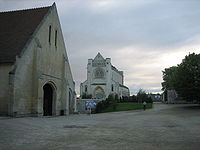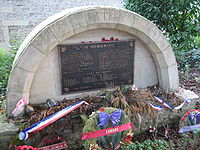
Ardenne Abbey
Encyclopedia

Premonstratensian
The Order of Canons Regular of Prémontré, also known as the Premonstratensians, the Norbertines, or in Britain and Ireland as the White Canons , are a Catholic religious order of canons regular founded at Prémontré near Laon in 1120 by Saint Norbert, who later became Archbishop of Magdeburg...
monastery in Saint-Germain-la-Blanche-Herbe
Saint-Germain-la-Blanche-Herbe
Saint-Germain-la-Blanche-Herbe is a commune in the Calvados department in the Basse-Normandie region in northwestern France.-Population:-External links:*...
, near Caen
Caen
Caen is a commune in northwestern France. It is the prefecture of the Calvados department and the capital of the Basse-Normandie region. It is located inland from the English Channel....
, France
France
The French Republic , The French Republic , The French Republic , (commonly known as France , is a unitary semi-presidential republic in Western Europe with several overseas territories and islands located on other continents and in the Indian, Pacific, and Atlantic oceans. Metropolitan France...
, containing a chapel built in 1121 and other medieval buildings.
The Abbaye was used as an observation post by the Germans
Germans
The Germans are a Germanic ethnic group native to Central Europe. The English term Germans has referred to the German-speaking population of the Holy Roman Empire since the Late Middle Ages....
in the Battle of Normandy
Battle of Normandy
The Invasion of Normandy was the invasion and establishment of Allied forces in Normandy, France, during Operation Overlord in World War II. It was the largest amphibious operation in history...
, and was heavily damaged by Allied forces. As a result, much of the Abbaye visible today has been rebuilt or restored.
Murders at the Ardenne Abbey
During the Normandy Campaign, Brigadeführer Kurt MeyerKurt Meyer
Kurt Meyer is the name of:*Kurt Meyer , Brigadeführer of Waffen-SS*Kurt Meyer , German soccer player*Kurt Meyer , member of the cantonal government of Lucerne, Switzerland, 1995–2005...
, commander of the 25th Panzer Grenadier Regiment, used the Ardenne Abbey for his regimental headquarters, as the turret allowed for a clear view of the battlefield. The abbey is the location where in June 1944, 20 Canadian soldiers were executed by members of the 12th SS Panzer Division.
Upon whom the responsibility for the killings fall, and the precise method in which they were carried out remain points of contention. Some basic facts, however, are certain.
In the evening of 7 June, 11 Canadian prisoners of war, soldiers from the North Nova Scotia Highlanders and the 27th Armoured Regiment (The Sherbrooke Fusiliers Regiment), were shot in the back of the head.
Of the North Nova Scotia Highlanders were:
- Private Ivan Crowe
- Private Charles Doucette
- Corporal Joseph MacIntyre
- Private Reginald Keeping
- Private James Moss
Of the 27th Armoured Regiment (The Sherbrooke Fusiliers Regiment) were:
- Trooper James Bolt
- Trooper George Gill
- Trooper Thomas Henry
- Trooper Roger Lockhead
- Trooper Harold Philip
- Lieutenant Thomas Windsor
The following day, 8 June, seven more POWs from the North Nova Scotia Highlanders were also executed:
- Private Walter Doherty
- Private Hollis McKeil
- Private Hugh MacDonald
- Private George McNaughton
- Private George Millar
- Private Thomas Mont
- Private Raymond Moore
On 17 June, two more Canadian soldiers, Lieutenant Fred Williams and Lance Corporal George Pollard, were also believed to have been killed at or around the abbey.
Discovery of the bodies
After liberating the Ardenne Abbey on 8 July, members of the Regina Rifle Regiment discovered the body of Lieutenant Williams; Lance Corporal Pollard was never found. The bodies of those killed on 7 and 8 June were not found until the winter and spring of 1945, when inhabitants from the abbey accidentally discovered remains throughout the premises. Examinations of the remains revealed that the soldiers had either been shot or bludgeoned directly in the head. All the remains were taken to the cemeteries at Beny-sur-MerBény-sur-Mer
Bény-sur-Mer is a commune in the Calvados department in the Basse-Normandie region in northwestern France.-World War II:Bény-sur-Mer was liberated on D-Day by Le Régiment de la Chaudière, the only French-speaking unit to take part in Operation Overlord. There was a gun battery located near the...
or Bretteville-sur-Laize
Bretteville-sur-Laize
Bretteville-sur-Laize is a commune in the Calvados department in the Basse-Normandie region in northwestern France.The scene of heavy fighting following the Normandy landings, much of the town is of post-WW2 construction.-Population:-Twin towns:...
, except for Private McKeil, who was taken to Ryes War Cemetery.
Trial of Kurt Meyer
Following a year of investigations from August 1944 to August 1945, the Canadian War Crimes Commission (CWCC), led by Lieutenant-Colonel Bruce Macdonald, strived to discover the details of the murders and who bore the responsibility. As commander of the regiment, Kurt Meyer remained the prime suspect. At Meyer’s war crimes trial in December 1945, the incident at the Abbaye formed the core of the charges. In total, five charges were laid against him:- Inciting and advising soldiers under his command to refuse quarter to Allied troops.
- Commanding his troops to kill 23 POWs at or near the villages of Buron and Authie on 7 June 1944.
- Commanding his troops, on 8 June 1944, to kill seven prisoners of war at the Abbaye Ardenne, and as a result of such orders the prisoners were shot and killed.
- (Alternative to third charge) Responsibility for the killing of seven Canadian POWs at the Abbaye Ardenne on 8 June 1944.
- Ordering for the killing of 11 Canadian POWs at the Abbaye Ardenne on 7 June 1944.
Former SS Private Alfred Helzel was the prosecution’s first major witness. While in prison in Quebec, Helzel revealed that in June 1944 Meyer had directed his troops to take no prisoners; on the stand, however, Helzel denied that Meyer made such a declaration. Macdonald eventually managed to have Helzel verify his original statement, thus helping to establish Meyer’s guilt.
Citizens of the towns of Authie and Buron testified against the 12th SS and the various atrocities committed against Canadian soldiers. Canadian soldiers themselves testified, the most important being Sergeant Stanley Dudka. He maintained that his column of prisoners arrived at the Abbaye Ardenne on 7 June, after which military police demanded 10 volunteers step forward. Since no one volunteered, 10 men were randomly taken, including Private Moss, later identified as one of the men executed at the Abbaye.
The prosecution’s central witness, however, was German soldier Jan Jesionek. At the Abbaye on 8 June 1944, Jesionek was approached by two SS troopers who were escorting seven Canadian prisoners, and watched as the POWs were directed into a stall adjoining the Abbaye. One of the troopers asked for the regimental commander, whereby Jesionek led him to Kurt Meyer. In response to learning of the seven prisoners, Meyer reportedly said: ‘What should we do with these prisoners; they only eat up our rations?’ Afterwards, he turned to one of the officers, spoke softly so that others could not hear, and then announced: ‘In the future, no more prisoners are to be taken.’ Jesionek then saw each prisoner questioned by the officer to whom Meyer had spoken. A name was called out, a prisoner walked up from the passageway leading to the garden in the Abbaye. As soon as the prisoner turned, the officer shot him in the head with a machine pistol; this was repeated for the remaining six prisoners. After the officer and guards left, Jesionek and three fellow drivers examined the bodies, all lying in the garden and surrounded by blood. According to Jesionek, the Canadians realized what was happening, each prisoner shaking hands with his comrades before walking to the garden and being shot. Uncertainty over Meyer’s commands remained since Jesionek never heard Meyer give the order to kill the Canadians.
Meyer originally claimed to have had no knowledge of the murders at the Abbaye. He later insisted, however, that he was aware of the bodies’ presence but had not seen them until two days after the killings. Disgusted, Meyer apparently ordered for the burial of the bodies and the admonishment, albeit unsuccessfully, of those responsible. These claims were refuted by French teenagers, however, who lived in the Abbaye and testified that no bodies were visible in the garden when they went there the day after the murders. Throughout the trial, Meyer maintained that he never commanded his troops to not take prisoners.
Outcome of Trial
Ultimately, Meyer was found guilty of of inciting his troops to commit murder and of being responsible as a commander for the killings at the Abbaye; he was acquitted on the second and third charges. Sentenced to death on 28 December 1945, his sentence was commuted to life imprisonment on 14 January 1946. After serving nearly nine years in prison, Meyer was released on 7 September 1954.Present


